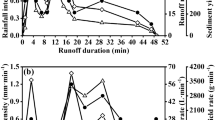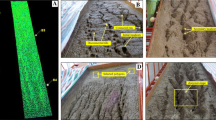Abstract
Rill formation is the predominant erosion process in slope land in the Loess Plateau, China. This study was conducted to investigate rill erosion characteristics and their effects on runoff and sediment yielding processes under different slope gradients at a rate of 10°, 15°, 20° and 25° with rainfall intensity of 1.5 mm min−1 in a laboratory setting. Results revealed that mean rill depth and rill density has a positive interrelation to the slope gradient. To the contrary, width-depth ratio and distance of the longest rill to the top of the slope negatively related to slope gradient. All these suggested that increasing slope steepness could enhance rill headward erosion, vertical erosion and the fragmentation of the slope surface. Furthermore, total erosion tended to approach a stable maximum value with increasing slope, which implied that there is probably a threshold slope gradient where soil erosion begins to weaken. At the same time, the correlation analysis showed that there was a close connection between slope gradient and the various indices of soil erosion: the correlation coefficients of slope gradient with maximal rill depth, number of rills and the distance of the longest rill from the top of the slope were 0.98, 0.97 and −0.98, respectively, indicating that slope gradient is the major factor of affecting the development of rills. Furthermore, runoff was not sensitive to slope gradient and rill formation in this study. Sediment concentration, however, is positively related to slope gradient and rill formation, the sediment concentrations increased rapidly after rill initiation, especially. These results may be essential for soil loss prediction.
Similar content being viewed by others
References
Bagnold RA (1966) An approach to the sediment transport problem from general physics. US Geological Survey Paper 422, Washington, USA.
Bennett SJ (1999) Effect of slope on the growth and migration of headcuts in rills. Geomorphology 30: 273–290. DOI: 10.1016/S0169-555X(99)00035-5
Berger C, Schulze M, Rieke-Zapp D, et al. (2010) Rill development and soil erosion: a laboratory study of slope and rainfall intensity. Earth Surface Processes and Landforms 35(12): 1456–1467. DOI: 10.1002/esp.1989
Bruno C, Stefano DC, Ferro V (2008) Field investigation on rilling in the experimental Sparacia area, South Italy. Earth Surface Processes and Landforms 33(2): 263–279. DOI: 10.1002/esp.1544
Brunton DA, Bryan RB (2000) Rill network development and sediment budgets. Earth Surface Processes and Landforms 25(7): 783–800. DOI: 10.1002/1096-9837(200007)25:7<783: AID-ESP106>3.0.CO;2-W
Bryan RB (1990) Knickpoint evolution in rillwash. Catena Supplement 17: 111–132.
Bryan RB, Poesen J (1989) Laboratory experiment on the influence of slope length on runoff, percolation and rill development. Earth Surface Processes and Landforms 14(3): 211–231. DOI: 10.1002/esp.3290140304
Cai QG (1998) Research of rill initiation condition on loess hillslopes. Journal of Sediment Research 1: 52–59. (In Chinese)
Capra A, Ferro V, Scicolone B (2005) Erosion of ephemeral gully in a small sicilian basin. Journal of Mountain Hydrology 24: 455–478. (In Italian)
Chen YZ (1987) A review: The study of soil erosion on Loess Plateau. Geographical Research 6(1): 76–85. (In Chinese)
De Santisteban LM, Casalì J, Lòpez JJ, et al. (2005) Exploring the role of topography in small channelerosion. Earth Surface Processes and Landforms 30: 591–599. DOI: 10.1002/esp. 1160
Fang HY, Cai QG, Chen H, et al. (2008) Effect of rainfall regime and slope on runoff in a gullied loess region on the Loess Plateau in China. Environmental. Management 42: 402–411. DOI: 10.1007/s00267-008-9122-6
Gilley JE, Kottwitz ER, Simanton JR (1990) Hydraulic characteristics of rills. Transactions of ASAE 33:1900–1906. DOI: 10.13031/2013.31556aaa
Giménez R, Govers G (2002). Flow detachment by concentrated flow on smooth and irregular beds. Soil Science Society of America Journal 66: 1475–1483. DOI: 10.2136/SSSAJ2002.1475
Giménez R, Planchon O, Silvera N, et al. (2004) Longitudinal velocity patterns and bed morphology interaction in a rill. Earth Surface Processes and Landforms 29: 105–114. DOI: 10.1002/esp.1021
Govers G (1992) Relationship between discharge, velocity and flow area for rills eroding loose, non layered materials. Earth Surface Processes and Landforms 17: 515–528. DOI: 10.1002/esp.3290170510
Govers G, Giménez R, Van Oost K (2007) Rill erosion: exploring the relationship between experiments, modelling and field observations. Earth Science Reviews 84(3-4): 87–102. DOI: 10.1016/j.earscirev.2007.06.001
Govers G, Poesen J (1988) Assessment of the interrill and rill contribution to total soil loss from an upland field plot. Geomorphology 1: 343–354. DOI: 10.1016/0169-555X(88)90006-2
He JJ, Cai QG, Liu SB (2012) Effects of slope gradient on slope runoff and sediment yield under different single rainfall conditions. Chinese Journal of Applied Ecology 23(5): 1263–1268. (In Chinese)
He JJ, Li XJ, Jia LJ, et al. (2014) Experimental study of rill evolution processes and relationships between runoff and erosion on clay loam and loess. Soil Science Society of America Journal 78(5): 1716–1725. DOI: 10.2136/sssaj2014.02.0063
Helming K, Römkens MJM, Prasad SN, et al. (1999) Erosional development of small scale drainage networks. In: Hergatren S et al. (Eds.), Process Modelling and Landform Evolution: Lecture Notes in Earth Science 78, Springer, Berlin. pp 123–146.
Huang CJ, Bradford M, Laflen JM (1996) Evaluation of the detachment-transport coupling concept in the WEPP rill erosion equation. Soil Science Society of America Journal 60: 734–739. DOI: 10.2136/sssaj1996.03615995006000030008x
Huo YY, Wu SF, Feng H (2011) Dynamic process of slope rill erosion based on three-dimensional laser scanner. Science of Soil and Water Conservation 9(2): 32–37. (In Chinese)
Jin CX (1995) A theoretical study on critical erosion slope gradient. Acta Geographica Sinica 50(3): 234–239. (In Chinese)
Kimaro DN, Poesen J, Msanya BM, et al. (2008) Magnitude of soil erosion on the northern slope of the Uluguru Mountains, Tanzania: Interrill and rill erosion. Catena 75: 38–44. DOI: 10.1016/j.catena.2008.04.007
Kinnell PIA (2000) The effect of slope length on sediment concentrations associated with side-slope erosion. Soil Science Society of America Journal 64: 1004–1008. DOI: 10.2136/sssaj2000.6431004x
Kinnell PIA, Cummings D (1993) Soil slope gradient interactions in erosion by rain-impacted flow. Transactions of the ASAE 36: 381–387.
Lei TW, Nearing MA (2000) Flume experiments for determining rill hydraulic characteristic erosion and rill patterns. Journal of Hydraulic Engineering 31(11): 49–55. (In Chinese)
Lei TW, Nearing MA, Haghighi K, et al. (1998) Rill erosion and morphological evolution: a simulation model. Water Resource Research 34: 3157–3168. DOI: 10.1029/98WR02162
Li Y, Zhang JH, Yang JC, et al. (2000) Spatial patterns of soil erosion on steep cultivated hillslope in Loess Plateau of Northern Shaanxi. Journal of Soil and Water Conservation 14(4): 17–21. (In Chinese)
Mancilla GA, Chen S, McCool DK (2005) Rill density prediction and flow velocity distribution on agricultural areas in the Pacific Northwest. Soil & Tillage Research 84: 54–66. DOI: 10.1016/j.still.2004.10.002
Morgan RPC (1977) Soil erosion in the United Kingdom: field studies in the Silsoe area, 1973-1975. Occasional Paper No. 4, National College of Agricultural Engineering, London, UK.
Nord G, Esteves M (2010) The effect of soil type, meteorological forcing and slope gradient on the simulation of internal erosion processes at the local scale. Hydrological Processes 24: 1766–1780. DOI: 10.1002/hyp.7613
Obiechefu GC, Morgan RP (1994) Rill initiation and evolution: a precursor for understanding gully erosion. Paper No. 942584, American Society of Agricultural Engineers, USA.
Rauws G (1987) The initiation of fills on plane beds of noncohesive sediments. Catena Supplement 8: 107–118.
Rejman J, Brodowski R (2005) Rill characteristics and sediment transport as a function of slope length during a storm event on loess soil. Earth Surface Processes and Landforms 30: 231–239. DOI: 10.1002/esp.1177
Renard KG, Me Cool DK, Cooley KR, et al. (1997). Rainfallrunoff erosivity factor (R). In: Predicting Soil Erosion by Water: A Guide to Conservation Planning with the Revised Universal Soil Loss Equation (RUSLE). Agriculture Handbook No. 703. Chapter 2, U.S. Department of Agriculture: Washington, 19–64.
Shi ZH, Fang NF, Wu FZ, et al. (2012). Soil erosion processes and sediment sorting associated with transport mechanisms on steep slopes. Journal of Hydrology 454-455: 123–130. DOI: 10.1016/j.jhydrol.2012.06.004
Torri D, Dfalanga M, Chisci G (1987) Threshold conditions for incipient rilling. Catena Supplement 8: 97–105.
Wainwright J, Parsons AJ (2002) The effect of temporal variations in rainfall on scale dependency in runoff coefficients. Water Resource Research 38(12): 7–1–7-10. DOI: 10.1029/2000WR000188
Wu PT, Zhou PH, Wu CL (1997) Research on the spatial distribution characters of slope rill erosion Research of Soil and Water Conservation 4(2): 47–56. (In Chinese)
Yan LJ, Yu XX, Lei TW, et al. (2008) Effects of transport capacity and erodibility on rill erosion processes: A model study using the Finite Element method. Geoderma 146: 114–120. DOI:10.1016/j.geoderma.2008.05.009
Zhang QW, Lei TW, Zhao J (2008) Estimation of the detachment rate in eroding rills in flume experiments using an REE tracing method. Geoderma 147: 8–15. DOI: 10.1016/j.geoderma.2008.07.002
Zheng FL, Tang KL (1997) Rill erosion process of steep slope land of the Loess Plateau. International Journal of Sediment Research 12(1): 52–59.
Author information
Authors and Affiliations
Corresponding author
Additional information
http://orcid.org/0000-0003-1367-5317
http://orcid.org/0000-0001-9877-866X
http://orcid.org/0000-0003-3481-5534
http://orcid.org/0000-0001-7139-0278
http://orcid.org/0000-0002-2363-7616
Rights and permissions
About this article
Cite this article
He, Jj., Sun, Ly., Gong, Hl. et al. The characteristics of rill development and their effects on runoff and sediment yield under different slope gradients. J. Mt. Sci. 13, 397–404 (2016). https://doi.org/10.1007/s11629-015-3490-1
Received:
Accepted:
Published:
Issue Date:
DOI: https://doi.org/10.1007/s11629-015-3490-1




